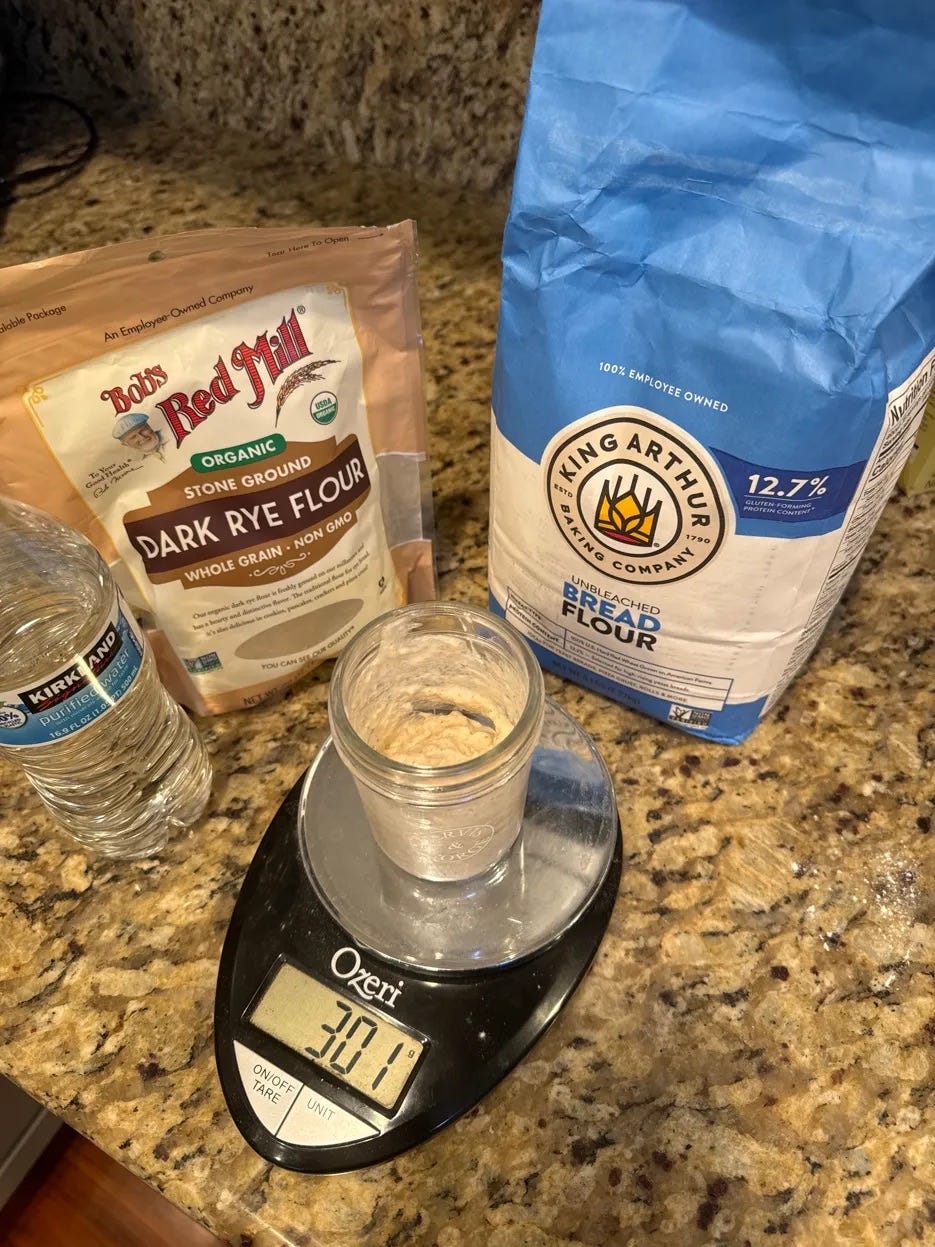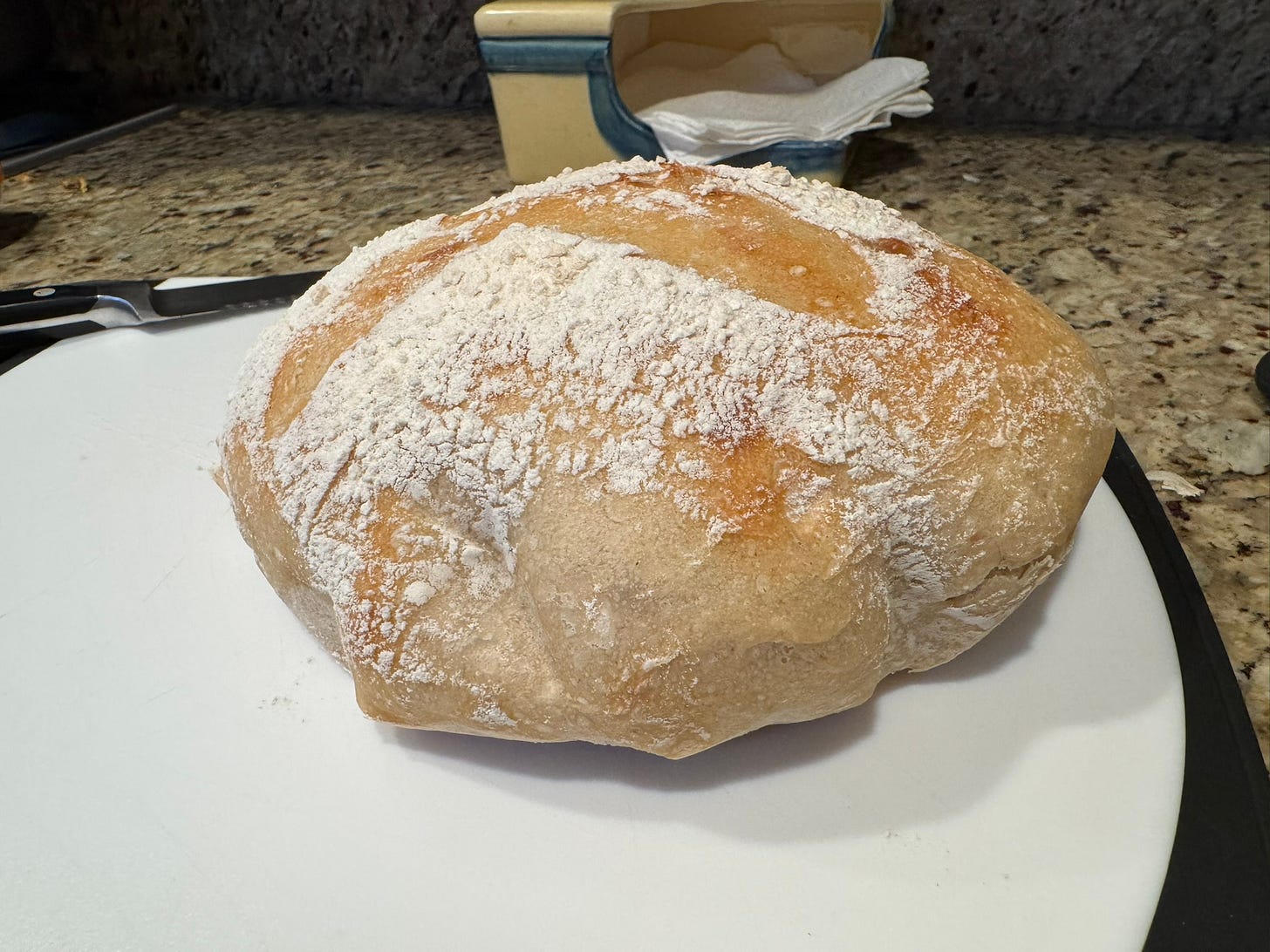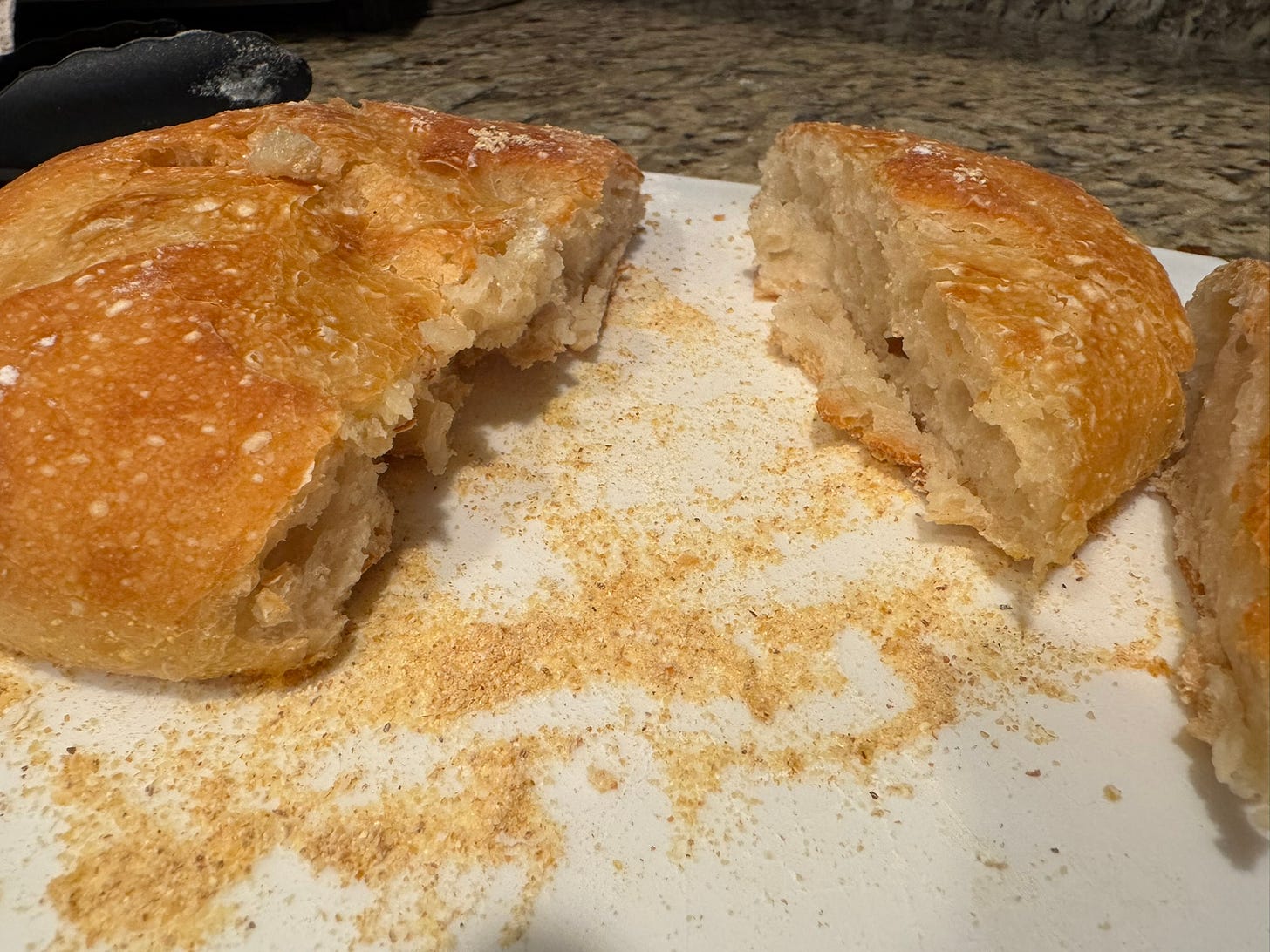Personal Science Week - 250911 Bread
My experiments with long-fermented homemade sourdough
The home kitchen is a great scientific laboratory. If you're not regularly conducting food experiments in your kitchen, you're missing one of the most fun and rewarding parts of personal science.
This week I summarize my various experiments with home bread-making, to see how easy it is to make a fresher, healthier kind from scratch.
Many top biohacker/personal fitness/nutrition people frown on bread for numerous reasons: it spikes your glucose for one thing. Others point to various "toxins" (compounds that supposedly discourage seed predation), not to mention the unhealthy additives in most commercial bread. Finally, we all know people who rave about the benefits of going gluten-free, a big part of which comes from giving up bread.
But I wonder how something so fundamental to civilization could possibly be unhealthy. I still remember my farmwife grandmother baking bread daily in a wood-fired oven, made from grain she had ground from scratch. You can't tell me that she wasn't eating healthy! Maybe it's just the commercially-processed stuff that's bad?
The Grain Debate: What Does Science Actually Say?
The published professional take on grains is more complex than the simple "good vs bad" categorization pushed by popular diet books. Meta-analyses consistently show that whole grain consumption reduces all-cause mortality by 16-18% and type 2 diabetes risk by 21-32%. Meanwhile, refined grains show neutral to slightly harmful effects.
The distinction between whole and refined grains seems critical. Whole grains contain the bran, germ, and endosperm, providing 12.8 grams of fiber per cup compared to just 3.4 grams in enriched white flour. But it's not just about fiber—refined flour loses 75% of its minerals and most phytonutrients during processing. The US government requires that all “enriched” bread flour add an additional five nutrients (iron, thiamin, riboflavin, niacin, folic acid), which still leaves out magnesium, zinc, vitamin E, and dozens of other compounds found naturally in wheat flour.
The Italy Question: Why American Bread Might Be Different
My recent trip to Italy (PSWeek250529) got me wondering if maybe it’s not bread per se that's problematic, but rather what's in American bread. There’s a big regulatory divide between US and European bread production:
Additives banned in Europe but allowed in US bread:
Potassium bromate (75 ppm limit in US): Classified as "possibly carcinogenic" by the International Agency for Research on Cancer
Azodicarbonamide (45 ppm in US): The "yoga mat chemical" that breaks down into potentially carcinogenic compounds
High fructose corn syrup: Unrestricted in US but limited in Europe
The FDA's Generally Recognized as Safe (GRAS) system allows companies to self-certify additives, resulting in 98.7% of new food chemicals entering the market without FDA review since 2000. Europe, by contrast, requires pre-market safety demonstration—a much higher bar, and probably one reason bakers there tend to stick to traditional ingredients.
The Sourdough Experiment
These concerns about commercial bread additives led me to try making my own sourdough from scratch. Like most personal scientists with a kitchen, I’ve successfully made homemade bread many times, but always from a recipe that requires a couple teaspoons of commercial bread yeast. But bread yeast is a modern invention, dating only from the late 1800s. Until then—and well into the 20th Century for home bakers like my grandmother—everyone used sourdough.
It turns out to be trivially simple! You literally just mix regular wheat flour with water and let it sit at room temperature for about a week, carefully “feeding” it once a day by discarding roughly half the mixture and replacing with fresh flour and water.
Though any type of grain flour will do, I made my sourdough starter using Bob's Red Mill Dark Rye flour. The dark rye has higher enzyme activity and wild yeast population than white flour—exactly what you need to kickstart fermentation. After seven days of daily feeding (25g flour + 25g water), I had a vigorous starter that could double in size within 6-8 hours.
It’s that easy! And once you have the sourdough starter, the rest of bread-making is equally simple: mix some of your starter with a cup or two of flour (and a little salt), add water till it’s a dough-like consistency, and let it sit on the counter for a few hours. Once it’s roughly doubled in size, throw it in an oven at 450ºF or so, and within half an hour you’ll have a perfect loaf of bread!
Other than an oven, making your own bread requires very little other equipment. Pros will use a fancy dutch oven to better control the moisture and heat, but I’ve made perfectly good bread using basic kitchen supplies, like a simple aluminum pot.
Turning it up a notch
Once I had the basic sourdough starter and bread figured out, I decided to try another method that I’d seen mentioned in Italian restaurants: Long-fermentation times. This one is easy too, but like many good things takes extra time. Instead of letting the dough rise for an afternoon, you put the dough in the refrigerator for a few days to let it ferment longer.
Commercial bakeries in the US — even the fancy gourmet ones — rarely bother with longer fermentation times. It takes up space and reduces the number of loaves you can bake and sell each day.
I also tried experiments with organic, unenriched flour. Anything “enriched” — even fancy brands like those from Whole Foods or King Arthur—contains additives you won’t find in traditional bread. The result of my extra effort? I haven’t measured these numbers myself, but you’ll read that with long-fermented unenriched bread:
Phytic acid decreases by 60-70% during standard sourdough fermentation, improving mineral absorption
FODMAPs drop by 69-75%, potentially explaining why people with IBS often tolerate sourdough better
Amylase-trypsin inhibitors (ATIs) degrade by 41-70%, reducing inflammatory responses
The glycemic impact supposedly improves too—sourdough bread has a glycemic index of 53-54 compared to white bread's 71-72.
The Anti-Grain Books: Science or Sensation?
Popular books like Wheat Belly and Grain Brain popularized anti-grain sentiment, but scientific evaluation reveals major flaws. Red Pen Reviews gave Grain Brain a scientific accuracy score of 0.7 out of 4, noting dangerous misinformation. (See PSWeek240919)
My conclusion is that the anti-bread people conflate refined and whole grain effects, cherry-pick data, and ignore contradictory evidence. Meta-analyses consistently show inverse relationships between whole grain consumption and the conditions these books claim grains cause. The Academy of Nutrition and Dietetics, American Heart Association, and major universities have all issued statements contradicting these books' core premises.
My Observations
What I've noticed (with all the caveats about self-reported, uncontrolled observations):
Sourdough seems more filling than commercial bread
No obvious digestive issues with either type
The ritual of making bread is satisfying in itself
My CGM shows glucose rises regardless of bread type—any differences would require extensive testing to detect and might not be meaningful
But let's be honest: these observations are confounded by a hundred variables. Did I feel more satisfied because the bread was homemade? Because I ate it more slowly? Because I paired it with different foods? Without controlling for these factors, my "data" is really just structured anecdote.
The Personal Science Bottom Line
The bread “good or bad” question brings up a typical challenge for personal scientists: the effects we're looking for are often subtle, multifactorial, and highly individual. For most people, traditionally fermented whole grain bread is fine—even beneficial. But individual responses vary widely.
Rather than accept blanket dietary advice from bestselling diet books, I've settled on a pragmatic approach: make sourdough with organic, unenriched flour because it's enjoyable, avoids questionable additives, and connects better with the dietary habits of my ancestors. Is it “healthier” in some measurable way? The differences are probably too small to matter for someone with an otherwise reasonable diet.
Remember: if something has kept humans alive for thousands of years, be skeptical of anyone telling you it's poison. But also be skeptical of your own ability to detect small effects in noisy self-tracking data.
Sometimes the best personal science conclusion is: "The extremes are probably wrong, traditional methods probably have value, and perfect is the enemy of good."
Personal Science Weekly Readings
Like my experiments with coffee metabolism and alcohol effects, bread represents another ancient fermented food that humans have consumed for millennia. Here are a few specific sites I relied on for my bread-baking experiments:
The Sourdough Framework on GitHub provides reproducible protocols for consistent bread-making—written by a programmer, for programmers
Modernist Pantry sells personal quantities of food additive ingredients normally available only to big food companies (in case you want to experiment with what industrial bakers use)
Tim Ferriss's Flavor Star chart (archived version here) that I mentioned in PSWeek 250109 on cooking—a great tool for kitchen experiments
Environmental Working Group's Dirty Dozen list shows which foods have highest pesticide residues (strawberries and spinach top the list, not grains)
Have you experimented with fermented foods? Other advice or questions you’d like to discuss, please let us know.





FWIW I eat a lot of bread, and it doesn't spike my blood sugar all that much, but YMMV
I know people who are "gluten intolerant" in the US, but have no issues in Europe. Don't know if this is due to the use of different wheat varieties, pesticide residues, or something else...